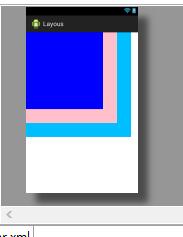Android开发之五大布局篇
一、Android中常用的5大布局方式有以下几种:
线性布局(LinearLayout):按照垂直或者水平方向布局的组件。
相对布局(RelativeLayout):相对其它组件的布局方式。
绝对布局(AbsoluteLayout):按照绝对坐标来布局组件。
表格布局(TableLayout):按照行列方式布局组件。
帧布局(FrameLayout):组件从屏幕左上方布局组件。
二、布局:
1、线性布局:线性布局是按照垂直或者水平方向来布局,通过“android:orientation”属性可以设置线性布局的方向。属性值有垂直(vertical)和水平(horizontal)两种。
常用的属性:
android:orientation:可以设置布局的方向,以列或行来显示。
android:gravity:用来控制组件的对齐方式,相对于父元素的重力方向。
layout_weight:控制各个组件在布局中的相对大小,对未占用空间水平或垂直分配权重值。
相关知识:
- android:layout_gravity 本元素相对于父元素的重力方向
- android:gravity 本元素所有子元素的重力方向
- android:orientation 线性布局以列或行来显示内部子元素
- android:layout_weight 子元素对未占用空间水平或垂直分配权重值
- 当 android:orientation="vertical" 时, 只有水平方向的设置才起作用,垂直方向的设置不起作用。即:left,right,center_horizontal 是生效的。!!!!
- 当 android:orientation="horizontal" 时, 只有垂直方向的设置才起作用,水平方向的设置不起作用。即:top,bottom,center_vertical 是生效的。!!!!
- android:layout_gravity 和 android:gravity 的区别
- android:gravity对元素本身起作用-本身元素显示在什么位置
- android:layout_gravity相对与它的父元素-元素显示在父元素的什么位置。
- 如:Button控件
- android:layout_gravity 表示button在界面上的位置
- android:gravity表示button上的字在button上的位置。
- 可选值[多选时用“|”分开]
- top、bottom、left、right、center_vertical、fill_vertical、center_horizontal、fill_horizontal、center、fill、clip_vertical。
- top 将对象放在其容器的顶部,不改变其大小.
- bottom 将对象放在其容器的底部,不改变其大小.
- left将对象放在其容器的左侧,不改变其大小.
- right将对象放在其容器的右侧,不改变其大小.
- center_vertical 将对象纵向居中,不改变其大小.
- 垂直对齐方式:垂直方向上居中对齐。
- fill_vertical 必要的时候增加对象的纵向大小,以完全充满其容器. 垂直方向填充
- center_horizontal 将对象横向居中,不改变其大小水平对齐方式:水平方向上居中对齐
- fill_horizontal 必要的时候增加对象的横向大小,以完全充满其容器. 水平方向填充
- center 将对象横纵居中,不改变其大小.
- fill 必要的时候增加对象的横纵向大小,以完全充满其容器.
- clip_vertical 附加选项,用于按照容器的边来剪切对象的顶部和/或底部的内容. 剪切基于其纵向对齐设置:顶部对齐时,剪切底部;底部对齐时剪切顶部;除此之外剪切顶部和底部.垂直方向裁剪
- clip_horizontal 附加选项,用于按照容器的边来剪切对象的左侧和/或右侧的内容. 剪切基于其横向对齐设置:左侧对齐时,剪切右侧;右侧对齐时剪切左侧;除此之外剪切左侧和右侧.水平方向裁剪
- 例子
- TextView要让文本垂直/水平居中显示,有两种情况需要考虑:
- 1、layout_width/layout_height为wrap_content,此时要让TextView在父控件上居中显示,必须设置layout_gravity=”center”。
- 2、layout_width/layout_height为fill_parent,此时由于TextView已占据父窗体所有空间,必须设置gravity=”center”。
2、相对布局:相对布局是按照组件之间的相对位置来布局,比如在某个组件的左边,右边,上面和下面等。
RelativeLayout用到的一些重要的属性:
- RelativeLayout用到的一些重要的属性:
- 第一类:属性值为true或false
- android:layout_centerHrizontal 水平居中
- android:layout_centerVertical 垂直居中
- android:layout_centerInparent 相对于父元素完全居中
- android:layout_alignParentBottom 贴紧父元素的下边缘
- android:layout_alignParentLeft 贴紧父元素的左边缘
- android:layout_alignParentRight 贴紧父元素的右边缘
- android:layout_alignParentTop 贴紧父元素的上边缘
- android:layout_alignWithParentIfMissing 如果对应的兄弟元素找不到的话就以父元素做参照物
- 第二类:属性值必须为id的引用名“@id/id-name”
- android:layout_below 在某元素的下方
- android:layout_above 在某元素的的上方
- android:layout_toLeftOf 在某元素的左边
- android:layout_toRightOf 在某元素的右边
- android:layout_alignTop 本元素的上边缘和某元素的的上边缘对齐
- android:layout_alignLeft 本元素的左边缘和某元素的的左边缘对齐
- android:layout_alignBottom 本元素的下边缘和某元素的的下边缘对齐
- android:layout_alignRight 本元素的右边缘和某元素的的右边缘对齐
- 第三类:属性值为具体的像素值,如30dip,40px
- android:layout_marginBottom 离某元素底边缘的距离
- android:layout_marginLeft 离某元素左边缘的距离
- android:layout_marginRight 离某元素右边缘的距离
- android:layout_marginTop 离某元素上边缘的距离
- EditText的android:hint
- 设置EditText为空时输入框内的提示信息。
- android:gravity
- android:gravity属性是对该view 内容的限定.比如一个button 上面的text. 你可以设置该text 在view的靠左,靠右等位置.以button为例,android:gravity="right"则button上面的文字靠右
- android:layout_gravity
- android:layout_gravity是用来设置该view相对与起父view 的位置.比如一个button 在linearlayout里,你想把该button放在靠左、靠右等位置就可以通过该属性设置.以button为例,android:layout_gravity="right"则button靠右
- android:layout_alignParentRight
- 使当前控件的右端和父控件的右端对齐。这里属性值只能为true或false,默认false。
- android:scaleType:
- android:scaleType是控制图片如何resized/moved来匹对ImageView的size。ImageView.ScaleType / android:scaleType值的意义区别:
- CENTER /center 按图片的原来size居中显示,当图片长/宽超过View的长/宽,则截取图片的居中部分显示
- CENTER_CROP / centerCrop 按比例扩大图片的size居中显示,使得图片长(宽)等于或大于View的长(宽)
- CENTER_INSIDE / centerInside 将图片的内容完整居中显示,通过按比例缩小或原来的size使得图片长/宽等于或小于View的长/宽
- FIT_CENTER / fitCenter 把图片按比例扩大/缩小到View的宽度,居中显示
- FIT_END / fitEnd 把图片按比例扩大/缩小到View的宽度,显示在View的下部分位置
- FIT_START / fitStart 把图片按比例扩大/缩小到View的宽度,显示在View的上部分位置
- FIT_XY / fitXY 把图片 不按比例扩大/缩小到View的大小显示
- MATRIX / matrix 用矩阵来绘制,动态缩小放大图片来显示。
- ** 要注意一点,Drawable文件夹里面的图片命名是不能大写的。
3、表格布局:表格布局是一个ViewGroup以表格显示它的子视图(view)元素,即行和列标识一个视图的位置。
android:shrinkColumns:收缩指定的列以适合屏幕,不会挤出屏幕
android:stretchColumns:尽量把指定的列填充空白部分
android:layout_column:控件放在指定的列
android:layout_span:该控件所跨越的列数
android:foreground:设置该帧布局容器的前景图像
android:foregroundGravity:设置前景图像显示的位置
- <?xml version="1.0" encoding="utf-8"?>
- <FrameLayout xmlns:android="http://schemas.android.com/apk/res/android"
- android:layout_width="match_parent"
- android:layout_height="match_parent" >
- <TextView
- android:layout_width="300dp"
- android:layout_height="300dp"
- android:background="#00BFFF" //淡蓝
- />
- <TextView
- android:layout_width="260dp"
- android:layout_height="260dp"
- android:background="#FFC0CB" //粉
- />
- <TextView
- android:layout_width="220dp"
- android:layout_height="220dp"
- android:background="#0000FF" // 蓝
- />
- </FrameLayout>

6、嵌套布局(线性布局与相对布局)
- <?xml version="1.0" encoding="utf-8"?>
- <LinearLayout xmlns:android="http://schemas.android.com/apk/res/android"
- android:layout_width="match_parent"
- android:layout_height="match_parent"
- android:orientation="vertical" >
- <TextView
- android:id="@+id/textView1"
- android:layout_width="match_parent"
- android:layout_height="177dp"
- android:background="#FF4500"
- android:text="111" />
- <TextView
- android:id="@+id/textView2"
- android:layout_width="match_parent"
- android:layout_height="162dp"
- android:background="#BCBFEF"
- android:text="222" />
- <RelativeLayout
- android:layout_width="match_parent"
- android:layout_weight="1"
- android:layout_height="406dp" >
- <TextView
- android:layout_weight="1"
- android:id="@+id/textView3"
- android:layout_width="124dp"
- android:layout_height="134dp"
- android:background="#c2c2c2"
- android:text="ccc" />
- <TextView
- android:layout_toRightOf="@id/textView3"
- android:id="@+id/textView4"
- android:layout_width="123dp"
- android:layout_height="136dp"
- android:background="#FF4500"
- android:text="bbb" />
- <TextView
- android:layout_toRightOf="@id/textView4"
- android:id="@+id/textView5"
- android:layout_width="119dp"
- android:layout_height="136dp"
- android:layout_weight="1"
- android:background="#c4c4c4"
- android:text="ttt" />
- </RelativeLayout>
- <TextView
- android:id="@+id/textView4"
- android:layout_width="123dp"
- android:layout_height="136dp"
- android:background="#FF4500"
- android:text="bbb" />
- <TextView
- android:layout_weight="1"
- android:id="@+id/textView5"
- android:layout_width="119dp"
- android:layout_height="136dp"
- android:background="#c4c4c4"
- android:text="ttt" />
- </LinearLayout>

Android开发之五大布局篇的更多相关文章
- Android开发-之五大布局
在html中大家都知道布局是什么意思了,简单来说就是将页面划分模块,比如html中的div.table等.那么Android中也是这样的.Android五大布局让界面更加美化,开发起来也更加方便.当然 ...
- Android中的五大布局
Android中的五大布局 1.了解布局 一个丰富的界面总是要由很多个控件组成的,那我们如何才能让各个控件都有条不紊地 摆放在界面上,而不是乱糟糟的呢?这就需要借助布局来实现了.布局是一种可用于放置很 ...
- android开发学习---layout布局、显示单位和如何进行单元测试
一.五大布局(layout) android中的用五大布局:LinearLayout (线性布局).AbsoluteLayout(绝对布局).RelativeLayout(相对布局).TableLay ...
- Android开发5大布局方式详解
Android中常用的5大布局方式有以下几种: 线性布局(LinearLayout):按照垂直或者水平方向布局的组件. 帧布局(FrameLayout):组件从屏幕左上方布局组件. 表格布局(Tabl ...
- android中的五大布局(控件的容器,可以放button等控件)
一.android中五大布局相当于是容器,这些容器里可以放控件也可以放另一个容器,子控件和布局都需要制定属性. 1.相对布局:RelativeLayout @1控件默认堆叠排列,需要制定控件的相对位置 ...
- Android开发之环境配置篇
Android环境配置: 一.JDK(不用安装) 1.拷贝 D:\Java\jdk1.8.0_91 文件内容 2. 安卓ADT ADT(Android Development Tools):安装ADT ...
- android开发 静态碎片布局实现
实现思维: 1.需要写2个或者多个子布局 2.写一个Java的class去实现将子布局与父类布局铺满.(一个子布局对应一个class) 3.在父类布局中导入fragment布局,并且添加android ...
- .Net程序猿玩转Android开发---(6)线性布局LinearLayout
LinearLayout控件是Android中重要的布局控件,是一个线性控件,所谓线性控件的意思是指该控件里面的内容仅仅能水平或垂直排列.也就 ...
- Android中的五大布局和logcat打印日志
在android中的布局有五大类,有的时候你可能用到一种,但有的时候你也可能需要两种或者三种布局同时一起使用.这五种布局为别为:LinearLayout(线性布局),FrameLayout(框架布局) ...
随机推荐
- angular的点击添加
首先是在js里面我们可以用clone来点击添加一些东西比如列表或者其他的div之类的,但是在angular里面怎么实现点击添加呢? 类似这种: 这样就尴尬了,最少我这样的菜鸟是不知道怎么去写的,网上好 ...
- MySql查询出来的值为 boolean类型的值
解决方案: status_flag * 1 as status_flag 乘以1之后就不会是boolean类型的值了
- linux简单快速启用web
================= jser.me/2013/11/22/快速启动web服务的两种方式.html Python的SimpleHTTPServer需要先安装python,然后执行 pyt ...
- [小A与最大子段和][斜率优化dp+二分]
链接:https://ac.nowcoder.com/acm/contest/545/A来源:牛客网题目描述 小A在网上看到了 "最大子段和" 问题的解法.第二天,小A向小B讲解了 ...
- nginx-port-Permission-denied
nginx use 9000 port Permission denied other port ok 新架构下web服务需要使用反向代理,将不同的请求转发到不同的service,对应不同的端口. ...
- linux kernel笔记
文章目录 关于linux内核中的__attribute__关键字 Linux kernel启动参数 gdt / ldt PCB 关于linux内核中的__attribute__关键字 part I: ...
- DOS命令之at命令详解
AT命令是Windows XP中内置的命令,它也可以媲美Windows中的“计划任务”,而且在计划的安排.任务的管理.工作事务的处理方面,AT命令具有更强大更神通的功能.AT命令可在指定时间和日期.在 ...
- react 知识点2
从 render 函数可以看出来,组件内部是通过 this.props 的方式获取到组件的参数的,如果 this.props 里面有需要的属性我们就采用相应的属性,没有的话就用默认的属性. 那么怎么把 ...
- linux应用之gcc环境的安装
使用如下两个命令就可把gcc,gcc-c++统统安装 yum -y install gcc yum -y install gcc-c++ 但是用yum install gcc安装gcc编译环境,关于 ...
- Spring4相关jar包介绍(转)
Spring4相关jar包介绍 spring-core.jar(必须):这个jar 文件包含Spring 框架基本的核心工具类.Spring 其它组件要都要使用到这个包里的类,是其它组件的基本核心,当 ...
